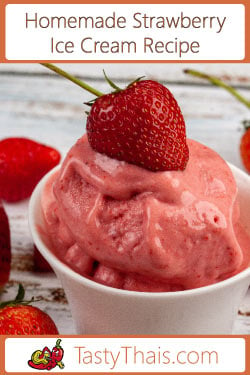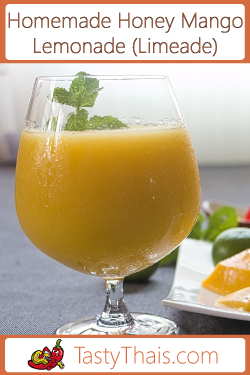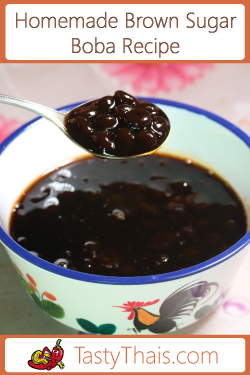Homemade ice cream is one of those things that cooks and kids, as well as grown males all, have on their list of things that might be exciting to do.
Reading the recipe that instructs you to take the ice cream out of the freezer and “whisk on the hour, every hour for several hours”, will lose the grown males to seek a different of exciting or perhaps visit a shop to find a machine to do it for them.
Kids will continue their interest, of course, because mum will do all the heavy lifting anyway. As for the cooks, they are permanently in the kitchen anyway so hourly mixing is really no hassle.
So, eager to please all our readers, we thought we would give you an overview of how to make homemade ice cream and the most common household ice cream making gadgets to lighten the load.
Chewck out our homemade strawberry ice cream recipe made with coconut cream or the video for a little inspiration?
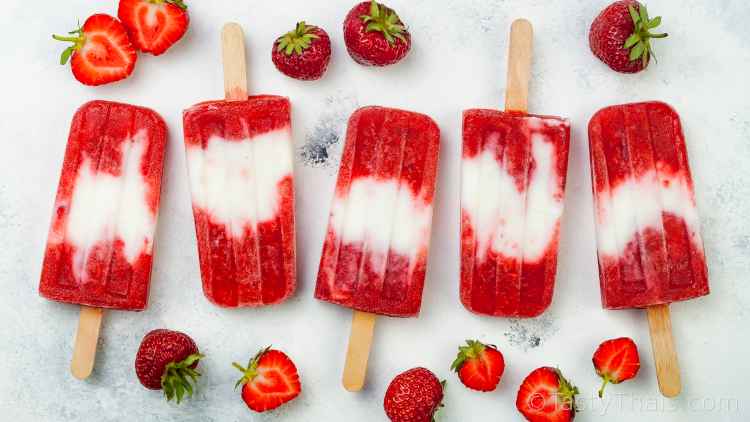
Homemade Ice Cream Method Overview
There are several types of ice cream that you can make easily at home.
All you are doing is making up a liquid mix that tastes awesome and then freezing it while fluffing it up at the same time which is the bit that tests your resolve.
If you are using dairy or coconut milk as the liquid then you will end up with a crystalline type ice cream similar to the cheap ice creams you buy from the store.
If you are using coconut or dairy cream (35%+ fat) as your liquid then you will end up with creamier and smoother ice cream than milk can produce. This is because the fat in the cream makes the ice crystal structure smaller which accordingly tastes smoother.
Using a mixture of yogurt and cream or milk will give you frozen yogurt.
A mixture of a small quantity of milk and fruit juice will result in a sherbet type ice cream.
If it is sorbet you are after then it will be fruit puree with added water and sugar that you’ll be freezing.
Then there’s bing su, a Korean style ice cream made from shaved frozen milk and likely many more varieties.
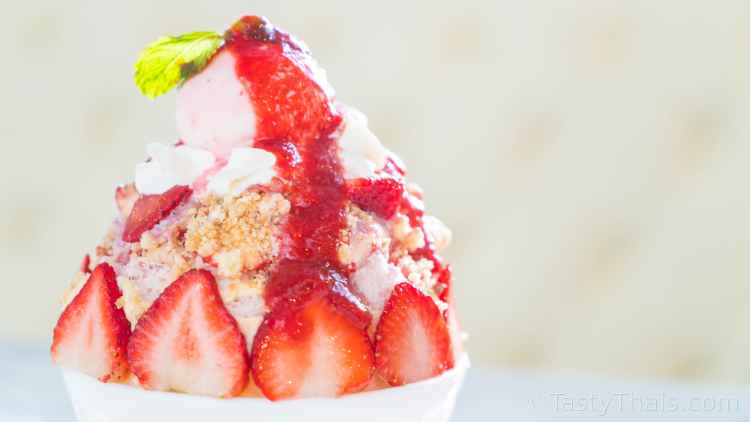
Making the Ice Cream Mix
Ice cream is basically a mix of the (usually sweetened) flavor base, such as fruit or chocolate, and the fat base such as eggs, dairy cream, coconut cream or yogurt.
The flavor and fat bases are mixed and then frozen.
That is ice cream 101.
But things are never quite so simple and of course, there is some intricate food science behind it all.
Freezing things means that the liquid turns to solid and in most instances, this means that the water content in the mix forms ice crystals which in turn make the liquid into cool and delicious ice cream.
The ingredients that are added to the mix and the balance between those ingredients affect how the mix behaves as it freezes. Air also has a part to play in the process as adding it provides a lighter texture because the trapped air bubbles break up the space between the ice crystals.
Water will form a solid block of ice on its own when frozen but when mixed with other ingredients the crystals are broken into smaller parts which produce less dense solidity and eventually a smoother consistency to the ice cream.
If you freeze fruit that contains water mixed with the fruit, then you will end up with a hard crystalline type texture to the fruit before it thaws. The more water in the mix, the more crystalline the texture.
If you freeze milk then you will also see the crystals if you examine the frozen milk. But if you freeze cream these crystals are not so visible because the fat in the cream emulsifies and traps the water more efficiently than the lower fat milk.
The water still freezes in crystals but because the water is trapped the crystals are much much smaller – hence a smoother and softer consistency.
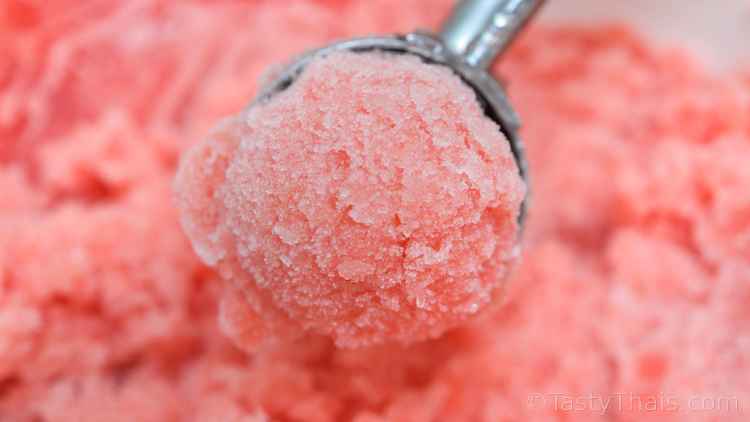
Why Do Many Ice Cream Recipes Call for Eggs – Specifically Egg Yolks?
Egg yolks are a mix of fat, water, and protein.
The fat in egg yolks is similar in proportion to the fat in cream and behaves similarly to cream except that it is a much better emulsifier. That means the molecules of fat and water bound together are smaller – which means even smaller ice crystals – which means smoother and creamier ice cream.
Eggs are also a stabilizer which enables your ice cream to last longer in the freezer as well as stay frozen for longer than a watery based ice cream because fat thaws slower than does water.
Adding egg yolks is a common method of producing creamier and longer-lasting, smoother ice cream. Because the eggs emulsify the ice cream mix even more, the ice cream takes longer to thaw and so keeps a better consistency.
So if you ever wondered why one ice cream stays solid as you eat your cone and another seems to dribble down before you had more than a couple of licks, you now know why.
The reason for THAT is that watery based ice cream melts relatively quickly even while it is out of the freezer for serving. Once the mix thaws, it loses its consistency and as it freezes, which means it freezes harder and more solid.
The problem with eggs is …. well they are eggs and have an eggy flavor. The more eggs you use the more eggy the taste.
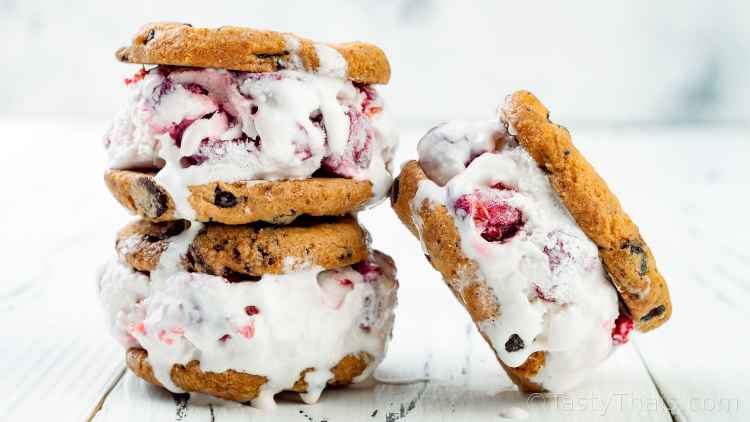
How to Get a Creamy Ice Cream Consistency
The key to getting a creamy consistency is forcing the water molecules to live closer apart which is mostly achieved by binding them to other ingredients such as fat from cream or stabilized emulsifiers such as egg yolks or the chemicals used in commercial ice creams.
Basically, the higher the fat content the softer and creamier the ice cream.
The better emulsified, the softer and creamier the ice cream and the longer it will take to melt.
And that, my friends, is why the best ice creams are usually based around a custard type mix made with eggs and using high-fat content cream.
I should add that all eggs are not created equal. The freshness of the egg and the food the chicken ate before popping it out will affect the taste and “egginess”. The milk from Jersey cows and the cream made from it is vastly different tasting to the carton packed mass-produced creams in the supermarket.
Even the sugar has its own qualities and taste and can also affect the consistency of the finished ice cream.
All of this together makes ice cream making an art and a wonderful journey of experimentation to find your perfect recipe.
Making Better Homemade Ice Cream with the Tools and Ingredients Available
Having covered all the above it is hopefully now clear that the process has many elements. Apart from the taste of the ingredients, the second most important factor is keeping your ice crystals small.
If you are making the ice cream manually, breaking up the ice crystals through manual stirring is key to not ending up with a solid block of ice cream that melts before it is soft enough to serve.
There are two main elements to this. Firstly, keeping the ice cream light by whisking vigorously to inject air, and freezing as rapidly as possible before the mixture starts to flatten out. Secondly, breaking up ice crystals to keep them as small as possible as they freeze.
Having your ingredients as cold as possible through the whisking process will satisfy the first problem. In practice, this means making up the mix and then refrigerating and flash freezing for half an hour before whisking up and then immediately freezing to make the ice cream.
To satisfy the second issue, since you cannot be in the freezer stirring it up continually, you’ll need to whip out the ice cream at regular intervals as it freezes to agitate and break up the ice crystals as they begin to form.
This process needs to be done regularly (which means hours of ‘hands-on’) since once the ice has fully formed you’ll not achieve anything with a fork or whisk and it needs to be done quickly so the mixture does not melt too much.
As for the required tools, you’ll need a decent mixer and/or hand whisk to break up the ice crystals in most recipes as they freeze. We like the silicone coated whisks because they are also handy for whisking in non-stick cookware.
You’ll also need a good quality storage box such as the sturdy boxes shown below which are easy to scoop out and seal well to reduce the formation of ice crystals on your ice cream as it freezes.
Lastly, a good quality scoop is essential. Cheap ones break after a few uses, especially if your ice cream is a bit hard and you cannot wait to scoop. Plastic ones do not retain the heat long enough to complete a scoop. Stainless steel scoops are the best, with easy-slide surfaces and because they retain heat long enough to scoop out a complete scoop without sticky. They will also let your ice cream off into your bowl more easily.
Best Type of Ice Cream Maker
Fully Automated Ice Cream Machines
If we had an unlimited budget then we would buy a dedicated ice cream maker with a built-in refrigeration unit and sensibly sized mixing bowl. The image below is on our wish list because the bowl size is not so small that it needs constant use and because it is quiet and cost-effective with a small footprint on the work-surface.
Frozen Bowl Type Ice Cream Makers
The next best type is the frozen bowl machine which is basically a special gel-filled bowl with a non-stick lining which is placed in the freezer in advance. The second part of the machine is a simple motor that turns a paddle to churn the ice cream as it is frozen by the pre-frozen bowl.
The issues with this type of machine are:
- the bowl needs about 24 hours or so to freeze enough to stay frozen long enough to freeze your ice cream
- you can’t make ice cream on the spur of the moment unless the bowl is permanently in the freezer – and they take up a lot of space
- storage of the machine when not in use
- bowl capability to cool the contents long enough to freeze them before the bowl gel thaws and it loses its efficiency.
On the plus side the machines are a lot cheaper to buy and save a lot of hassle over making your ice cream completely manually.
The model we are using is a Kenwood and rather old. Here is the one we would buy today.
Ice & Salt Ice Cream Makers
If you go to a local Thai market you will likely find an ice lolly stall where soft drinks are poured into special little stainless steel tubes that are suspended in a large bucket holding ice, ice water, and salt.
The salt in the water drops its freezing temperature below freezing (you remember your chemistry right?) and so freezes the soft drink to create a lolly for sale at 5 baht a pop.
Even in Thailand where temperatures are usually near 30°C, these contraptions are capable of making ice lollies and out under the hot sun too.
We are not suggesting you have such a contraption at home but there are home versions. Compared to the frozen bowl versions they are not much cheaper (though usually make a larger batch in a single process). Also, there is the cost of ice and rock salt for the process which makes them a little bit more expensive in use.
Then there is all the mess and hassle of dealing with the ice and salt at the end – reasons which prompted the development of the frozen bowl type which we think is better for most people.
They do have their place at parties and BBQs where they come into their own because of their larger capacity – at least double.
Note that the ice cream that comes out of the unit is pretty soft scoop and really benefits with some extra freezing to finish it off.
Here’s an example of that type.
Conclusion
It’s horses for courses but we can conclude that the refrigerated all-in-one ice cream makers produce the creamiest ice cream from the same mix compared to other methods. The more ice cream you make, the more benefit you’ll get from an ice cream maker with built-in compressor.
The more expensive models may or may not be quieter, price does not correlate with the quantity produced and so the Whynter models seem to give the best bang for your buck and of those we like the Whynter ICM-201SB for its small footprint and half-gallon capacity or if you have space the cheaper but otherwise similar wider but shorter model Whynter ICM-200LS .
For occasional small quantities or for those on a budget, the best home frozen-bowl type ice cream maker is Cuisineart ICE-30BC which has a bigger capacity than its not much cheaper smaller model and its main rivals and is significantly cheaper than the models with gimmicky timers, etc.
There is no point in a timer since the time taken to freeze is so widely depending on the specific ice cream mix so don’t waste your money.
If you have a Kitchen Aid or Cuisine Art mixer then there are attachments available but these are more expensive than a dedicated machine which seems a bit pointless except for brand loyalty and potentially saving a bit of space. The attachments don’t even match all models so take care in choosing the correct one for your machine.
For parties and BBQ’s you might want to consider a bigger capacity ice and salt model which can handle 4 quarts at a time. Plus you will not be hogging a freezer shelf and it’s remarkably competent, cheap to purchase but there are the costs of ice and rock salt that cost more than the electric machines use in electricity.
Other posts you might like:

I am a Thai mum and love cooking for my children. Over the years, I have taken my family recipes as well as ones borrowed from friends and adapted them to make them even tastier. I publish my authentic Thai Food Recipes here for all to enjoy around the world. When I get a chance to travel I publish information to help others visiting Thailand.



